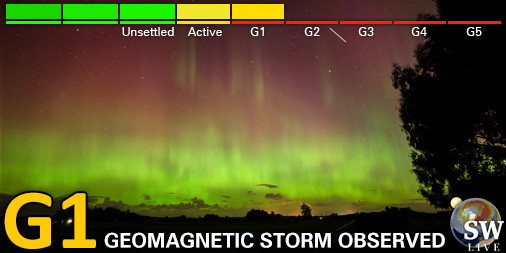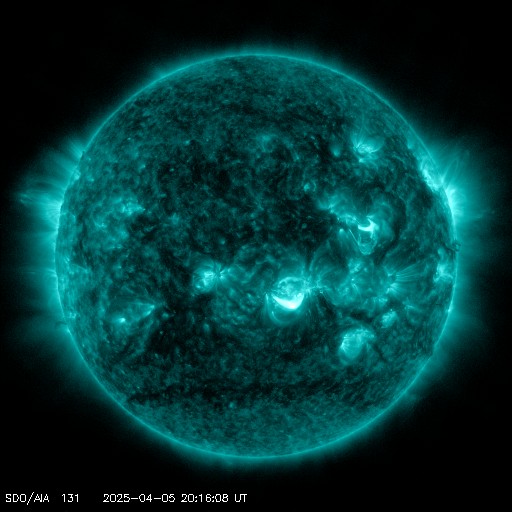Viewing archive of Monday, 1 May 2023
Daily bulletin on solar and geomagnetic activity from the SIDC
Issued: 2023 May 01 1239 UTC
SIDC Forecast
Solar flares
M-class flares expected (probability >=50%)
Geomagnetism
Quiet (A<20 and K<4)
Solar protons
Quiet
| 10cm flux | Ap | |
|---|---|---|
| 01 May 2023 | 150 | 006 |
| 02 May 2023 | 150 | 007 |
| 03 May 2023 | 150 | 007 |
Bulletin
Solar flaring activity was at moderate levels over the past 24 hours. The largest flare was a M2.4-class flare located in the NOAA Active region 3293 that rotated over the East limb. The most magnetically complex region produced C-class flare. The flaring activity is expected to remain moderate with small chance of X-class flare.
Few coronal mass ejections and flows were observed in the available SOHO/LASCO coronagraph imagery and automatically detected by the Cactus tool over the past 24 hours. However, no clear Earth-directed coronal mass ejections were identified.
The greater than 10 MeV proton flux was at the background levels over the past 24 hours. The proton flux is expected to be at the background levels over the next day. The greater than 2 MeV electron flux was above the 1000 pfu threshold due to the enhanced solar wind condition and is expected to remain at that level over the next days. The 24-hour electron fluence was at moderate levels and is expected to remind at moderate levels over the next 24 hours.
The influence of the solar wind streams associated to the negative polarity coronal hole reminds low. The solar wind speed ranged between 450 km/s and 560 km/s. The total interplanetary magnetic showed the values below 5.6 nT, and the southward interplanetary magnetic component, Bz, fluctuated between -3.9 nT and 4.4 nT. The solar wind conditions near Earth is expected to remain elevated for the next 1-2 days. The solar wind parameters are expected to remain stable for the next 24 hours.
Geomagnetic conditions were globally quiet with unsettle conditions (NOAA- Kp 1 to 3, K-BEL 1 to 3), during the last 24 hours. For the next 24 hours, they are expected to remain mainly quiet.
Today's estimated international sunspot number (ISN): 102, based on 12 stations.Solar indices for 30 Apr 2023
| Wolf number Catania | /// |
| 10cm solar flux | 154 |
| AK Chambon La Forêt | /// |
| AK Wingst | 012 |
| Estimated Ap | 011 |
| Estimated international sunspot number | 100 - Based on 29 stations |
Noticeable events summary
| Day | Begin | Max | End | Loc | Strength | OP | 10cm | Catania/NOAA | Radio burst types |
|---|---|---|---|---|---|---|---|---|---|
| 30 | 1956 | 2028 | 2043 | ---- | M2.4 | --/3293 | |||
| 01 | 0055 | 0121 | 0129 | ---- | M1.1 | 67/3288 |
Provided by the Solar Influences Data analysis Center© - SIDC - Processed by SpaceWeatherLive
All times in UTC
Current data suggests there is a moderate possibility for aurora to appear at the following high latitude regions in the near future
Norilsk, VorkutaCurrent data suggests there is a slight possibility for aurora to appear at the following middle latitude regions in the near future
Surgut, SyktyvkarLatest news
Latest forum messages
Support SpaceWeatherLive.com!
A lot of people come to SpaceWeatherLive to follow the Sun's activity or if there is aurora to be seen, but with more traffic comes higher server costs. Consider a donation if you enjoy SpaceWeatherLive so we can keep the website online!

Latest alerts
17:33 UTC - Hemispheric Power Index
The OVATION model predicts the Hemispheric Power Index to reach 51GW at 18:18 UTC
Sunday, 6 April 2025
02:00 UTC - Geomagnetic activity
Minor G1 geomagnetic storm (Kp5) Threshold Reached: 01:50 UTC
Saturday, 5 April 2025
20:30 UTC - Geomagnetic activity
Minor G1 geomagnetic storm (Kp5) Threshold Reached: 20:20 UTC
20:24 UTC - Solar flare
Moderate M1.05 flare
20:09 UTC - Radio Blackout
Minor R1 radio blackout in progress (≥M1 - current: M1.05)
Space weather facts
| Last X-flare | 2025/03/28 | X1.1 |
| Last M-flare | 2025/04/05 | M1.0 |
| Last geomagnetic storm | 2025/04/06 | Kp5 (G1) |
| Spotless days | |
|---|---|
| Last spotless day | 2022/06/08 |
| Monthly mean Sunspot Number | |
|---|---|
| March 2025 | 134.2 -20.4 |
| April 2025 | 148.7 +14.5 |
| Last 30 days | 132.7 -9.9 |





